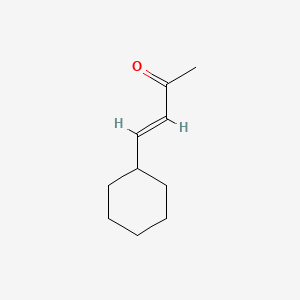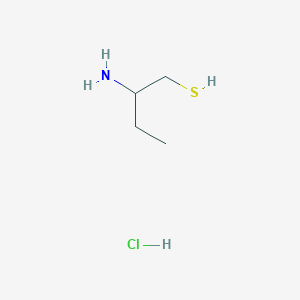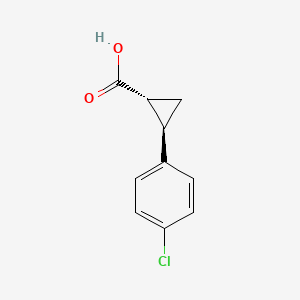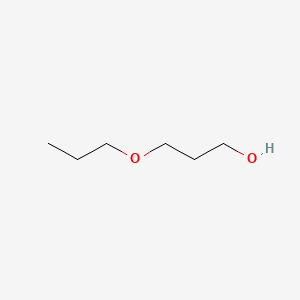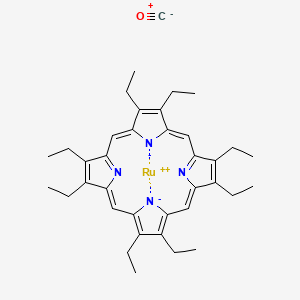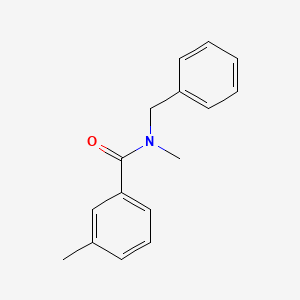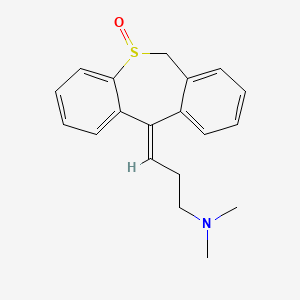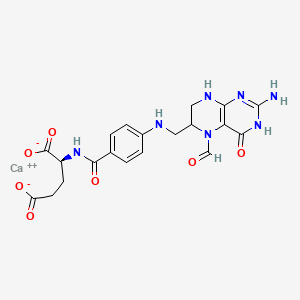
CID 135738681
- Haga clic en CONSULTA RÁPIDA para recibir una cotización de nuestro equipo de expertos.
- Con productos de calidad a un precio COMPETITIVO, puede centrarse más en su investigación.
Descripción general
Descripción
The compound with the identifier “CID 135738681” is a chemical entity listed in the PubChem database. It is characterized by its unique molecular structure and properties, which make it of interest in various scientific fields.
Métodos De Preparación
Synthetic Routes and Reaction Conditions
The preparation of CID 135738681 involves specific synthetic routes. One such method includes reacting 2-fluoro-4-substituted phenylacetic acid with a Vilsmeier reagent, followed by quenching the reaction solution in an aqueous solution to obtain an intermediate . This intermediate is then further processed to yield the final compound.
Industrial Production Methods
Industrial production methods for this compound typically involve large-scale synthesis using optimized reaction conditions to ensure high yield and purity. The exact details of these methods are often proprietary and may vary between manufacturers.
Análisis De Reacciones Químicas
Types of Reactions
CID 135738681 undergoes various chemical reactions, including:
Oxidation: This reaction involves the addition of oxygen or the removal of hydrogen.
Reduction: This reaction involves the addition of hydrogen or the removal of oxygen.
Substitution: This reaction involves the replacement of one atom or group of atoms with another.
Common Reagents and Conditions
Common reagents used in these reactions include oxidizing agents like potassium permanganate, reducing agents like lithium aluminum hydride, and various nucleophiles for substitution reactions. The conditions for these reactions typically involve controlled temperatures and pH levels to ensure the desired outcome.
Major Products
The major products formed from these reactions depend on the specific reagents and conditions used. For example, oxidation may yield carboxylic acids, while reduction may produce alcohols.
Aplicaciones Científicas De Investigación
CID 135738681 has a wide range of applications in scientific research:
Chemistry: It is used as a reagent in various organic synthesis reactions.
Biology: It serves as a tool for studying biochemical pathways and molecular interactions.
Medicine: It is investigated for its potential therapeutic effects and as a lead compound in drug development.
Industry: It is utilized in the production of specialty chemicals and materials.
Mecanismo De Acción
The mechanism of action of CID 135738681 involves its interaction with specific molecular targets and pathways. It may bind to enzymes or receptors, modulating their activity and leading to various biological effects. The exact molecular targets and pathways can vary depending on the context of its use.
Comparación Con Compuestos Similares
Similar Compounds
Similar compounds to CID 135738681 include other fluorinated phenylacetic acid derivatives and related chemical entities. These compounds share structural similarities but may differ in their specific functional groups and properties.
Uniqueness
What sets this compound apart from similar compounds is its unique combination of functional groups and molecular structure, which confer specific reactivity and biological activity. This uniqueness makes it a valuable compound for targeted research and applications.
Conclusion
This compound is a versatile compound with significant importance in various scientific fields. Its unique properties and reactivity make it a valuable tool for research and industrial applications.
Propiedades
Número CAS |
41927-89-3 |
|---|---|
Fórmula molecular |
C20H31CaN7O12 |
Peso molecular |
601.6 g/mol |
Nombre IUPAC |
calcium;(2S)-2-[[4-[(2-amino-5-formyl-4-oxo-3,6,7,8-tetrahydropteridin-6-yl)methylamino]benzoyl]amino]pentanedioate;pentahydrate |
InChI |
InChI=1S/C20H23N7O7.Ca.5H2O/c21-20-25-16-15(18(32)26-20)27(9-28)12(8-23-16)7-22-11-3-1-10(2-4-11)17(31)24-13(19(33)34)5-6-14(29)30;;;;;;/h1-4,9,12-13,22H,5-8H2,(H,24,31)(H,29,30)(H,33,34)(H4,21,23,25,26,32);;5*1H2/q;+2;;;;;/p-2/t12?,13-;;;;;;/m0....../s1 |
Clave InChI |
NPPBLUASYYNAIG-ZIGBGYJWSA-L |
SMILES |
C1C(N(C2=C(N1)N=C(NC2=O)N)C=O)CNC3=CC=C(C=C3)C(=O)NC(CCC(=O)O)C(=O)O.O.O.O.O.O.[Ca] |
SMILES isomérico |
C1C(N(C2=C(N1)N=C(NC2=O)N)C=O)CNC3=CC=C(C=C3)C(=O)N[C@@H](CCC(=O)[O-])C(=O)[O-].O.O.O.O.O.[Ca+2] |
SMILES canónico |
C1C(N(C2=C(N1)N=C(NC2=O)N)C=O)CNC3=CC=C(C=C3)C(=O)NC(CCC(=O)[O-])C(=O)[O-].O.O.O.O.O.[Ca+2] |
Números CAS relacionados |
58-05-9 (Parent) |
Solubilidad |
DMSO « 1 (mg/mL) H2O 100 (mg/mL) 0.1 N NaOH < 20 (mg/mL) |
Origen del producto |
United States |
Retrosynthesis Analysis
AI-Powered Synthesis Planning: Our tool employs the Template_relevance Pistachio, Template_relevance Bkms_metabolic, Template_relevance Pistachio_ringbreaker, Template_relevance Reaxys, Template_relevance Reaxys_biocatalysis model, leveraging a vast database of chemical reactions to predict feasible synthetic routes.
One-Step Synthesis Focus: Specifically designed for one-step synthesis, it provides concise and direct routes for your target compounds, streamlining the synthesis process.
Accurate Predictions: Utilizing the extensive PISTACHIO, BKMS_METABOLIC, PISTACHIO_RINGBREAKER, REAXYS, REAXYS_BIOCATALYSIS database, our tool offers high-accuracy predictions, reflecting the latest in chemical research and data.
Strategy Settings
| Precursor scoring | Relevance Heuristic |
|---|---|
| Min. plausibility | 0.01 |
| Model | Template_relevance |
| Template Set | Pistachio/Bkms_metabolic/Pistachio_ringbreaker/Reaxys/Reaxys_biocatalysis |
| Top-N result to add to graph | 6 |
Feasible Synthetic Routes
Descargo de responsabilidad e información sobre productos de investigación in vitro
Tenga en cuenta que todos los artículos e información de productos presentados en BenchChem están destinados únicamente con fines informativos. Los productos disponibles para la compra en BenchChem están diseñados específicamente para estudios in vitro, que se realizan fuera de organismos vivos. Los estudios in vitro, derivados del término latino "in vidrio", involucran experimentos realizados en entornos de laboratorio controlados utilizando células o tejidos. Es importante tener en cuenta que estos productos no se clasifican como medicamentos y no han recibido la aprobación de la FDA para la prevención, tratamiento o cura de ninguna condición médica, dolencia o enfermedad. Debemos enfatizar que cualquier forma de introducción corporal de estos productos en humanos o animales está estrictamente prohibida por ley. Es esencial adherirse a estas pautas para garantizar el cumplimiento de los estándares legales y éticos en la investigación y experimentación.


